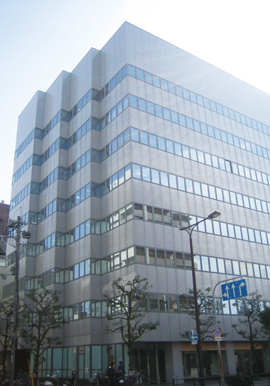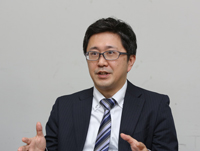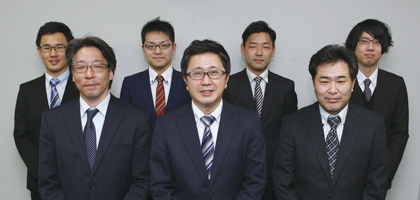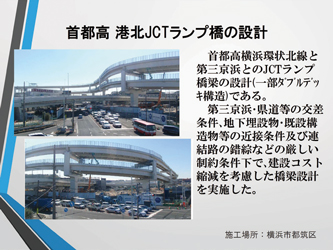 |
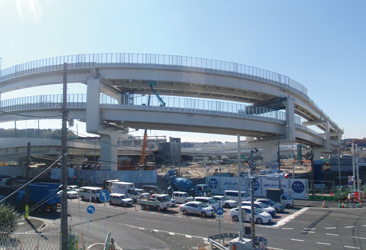 |
[Bridge] Design of Ramp bridge at Shutoko Kohoku junction, Tsuzuki-ku,
Yokohama City,
Kanagawa Construction Bureau, Metropolitan Expressway Company Limited |
Engineering Department #4, which we visited this time, deals with design of new road bridges as its main business among all kinds of bridges. In recent years, however, they receive more orders than before about pedestrians’ overpasses and pedestrian decks in station squares etc. In such places, landscape or integral design with parks may sometimes be requested; therefore, it is so organized to cooperate with other departments and sections, according to Mr. Tashiro.
Another characteristic trend about bridge design is to design by effectively
utilizing existing bridges. For example, in a project for widening the
existing bridge (current road), unlike construction of new bridge, it is
examined whether to "integrate with an existing bridge" or "separate
them structurally" after grasping information about the existing bridge.
According to him, cases of former approaches are increasing in recent years,
that is, keeping the current road and widening it.
"I think that widening (of existing bridges) is more difficult (in
some respects) than (design of) new bridges."
For example, when trying to integrate with an existing bridge, the work tends to have not a little influence on the existing bridge, such as a change in stress balance in the stage of widening the width of the existing bridge. That is, while an existing bridge is based on the old standard in accordance with the year of design as a matter of course, the part to be newly widened should comply with the most up-to-date standard. After both parts are integrated together, they are evaluated as one bridge. Therefore, it may be required to reinforce existing girders depending on the case. Furthermore, materials at the time when the existing bridge was designed are not necessarily provided. In addition, it is also necessary to inspect the condition of degradation of the existing bridge. As such, there are not a few elements to take more time and efforts than a new bridge, says Mr. Ryouhei Hamada, Technical Section Manager, Engineering Department #4.
On the other hand, in widening the width, if the existing bridge and the new one can be separated structurally, there may be no increase in burden to the existing bridge, making the repair and reinforcement to be the least with low cost. For this reason, in making design proposal, the Department takes the procedure in which they examine the structure that does not increase a burden on the existing bridge first. If it is impossible, they try to design a structure to integrate with the existing bridge.
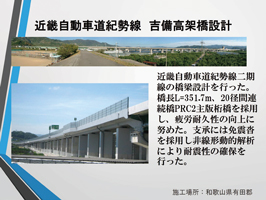 |
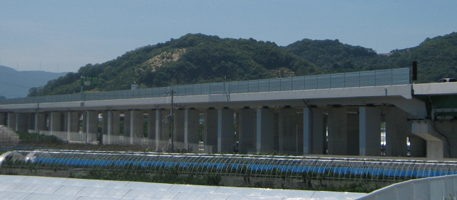 |
[Bridge] Design of Kibi viaduct on Kisei Line, Kinki Expressway, Kibi-cho,
Arita-county, Wakayama,
Japan Highway Public Corporation, Kansai Branch |
Introducing a Variety of FORUM8 Software Products, Relative Importance Increases Steadily
The company has adopted diverse kinds of FORUM8 products. Engineering Department
#4, which performs detailed design of bridges and preliminary design, have
those related to Bridge Superstructure Design, Bridge Substructure Design,
Foundation Design, and Structural Analysis. Other departments have those
related to Road Work Design and Harbor and others included in "UC-1
series". In addition, they also have UC-win/Road and FEM Analysis
related programs such as UC-win/FRAME(3D) and Engineer's Studio®.
Mr. Hamada has a leading role in business practice of bridge design, using FORUM8 products by himself, including those related to Bridge Superstructure and Substructure Design, Foundation Design, and Seismic Design. He mentioned their characteristics such as easiness to use FORUM8 products, collaboration of different software products across fields such as Bridge Superstructure Design and Substructure Design, and early support for modeling functions. He remembers that evaluation on such things has promoted expansion of a lineup of FORUM8 products.
In contrast, as the background for the increase in the share of FORUM8
products while introducing multiple products made by different manufacturers
for the purpose of same use, Mr. Tashiro pays attention to versatility
of FORUM8 products capable of supporting various cases, which are not found
in other products. He says that FORUM8 reacts quickly to users' requests
and guesses that accumulation of know-hows made through such a process
has helped improve their products into convenient and highly versatile
software.
"They are visually easy to understand, though it may be because I
am accustomed to using it," says Mr. hamada for his impression about
our software products. Regarding the software for Foundation Design and
Bridge Substructure Design, three-dimensional models are displayed as a
user inputs figures. The user can work while confirming positional relationship
etc. visually in real time. He expounds the merit that the user can avoid
reworking with this feature.
UC-win/Road has been used mainly in Engineering Department #2 for proposal-type projects such as safety verification of improvement in intersections or traffic simulation after completion of the merging section of an interchange. Especially in recent years, since it has become more and more important to prepare materials that are as easy to understand as possible in order to build consensus among the concerned parties including the client and local residents, opportunities of utilizing UC-win/Road are expected to increase also in Engineering Department #4.
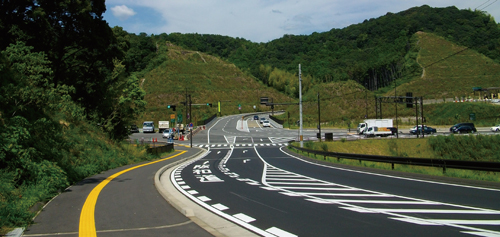 |
Detailed road design of Inari River Bridge on Tanabe-nishi Bypass and others,
Tanabe-city, Wakayama,
MLIT Kinki Regional Development Bureau, Kinan Office of River and National
Highway |
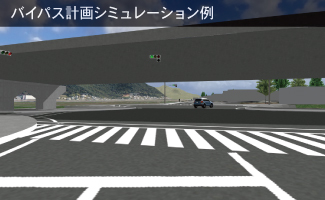 |
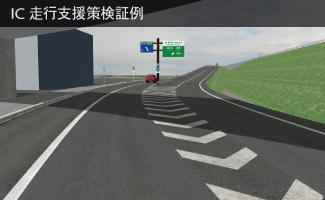 |
| Utilizing VR simulation that uses UC-win/Road in road planning as wall |
Moreover, in the project of widening the existing bridge mentioned before,
since there is no dedicated software for widening, they used existing software
applications for bridge superstructure design after rearranging the conditions.
On the other hand, with regard to bridge substructure design, Mr. Hamada
illustrated a case of an abutment the existing substructure that is incapable
of securing stability according to the current standard and that cannot
be reinforced easily because of strict constraint conditions. While common
abutment design applications assume that earth pressure is put from the
top to the bottom, "FORUM8's 'Abutment design' consciously treats
the earth pressure reduction method (which tends to be adopted in this
kind of projects), assuming that earth pressure should not be put over
a certain range. This makes it easy to set (necessary) arbitrary settings,"
says Mr. Hamada, evaluating it. In addition, he states other aspects that
it has many functions applicable not only to standard bridges but also
to widening projects such as design of irregular bridge and design of reinforcing
foundation.
Challenges in Supporting CIM and Future Expectation
“i-Construction is preceded by construction sites. (As part of it) in relation to ICT (information and communication technology) construction, also in the design stage 3D models are increasingly created to serve as the foundation for that, sent to the execution stage, and utilized for as-built management etc.”
However, though taking into account of CIM that is the target ahead, Mr. Hamada mentioned difference between the stance of bridge design of which he and his colleagues are in charge and that of earth work, and great difference from CIM that aims at utilizing 3D models up to the maintenance stage at last. He says that as a lead to help this, they have been checking interference using 3D models on reinforcement arrangement depending on projects.
Mr. Tashiro also pointed out that drawing by 3D CAD takes time under the present conditions. He considers the most important challenge is how to create 3D drawings efficiently towards the future when CIM is getting required.
In other words, in the mechanism of CIM, constructers are assumed to receive various advantages by using 3D models. In the upstream, it is also expected for constructing consultants who lays the foundation (3D models) to improve in productivity. However, there is also a different side; works that needs time and efforts may increase depending on the case, leaving its image that it needs troublesome reaction not swept away.
"While putting out our antenna to gather information about new technologies,
we are always trying to take in new technologies that sound good if any,
and thinking if we can lead them to better proposals."
Mr. Tashiro mentions the stance of the company including its support for i-Construction and CIM as above, and expects the potential for utilizing FORUM8 products for this.
Awards and recognition in 2017
"Redesign of Izeki River Bridge on Route 24"
Award by Kyoto National Road Office,
Kinki Regional Development Bureau of MLIT /
Excellent engineer award
"Detailed Design of Gosho Minami PA"
Award by Nara National Road Office,
Kinki Regional Development Bureau, MLIT /
Excellent engineer award
"Review of safety facilities and
strategic redesign of dangerous spots"
Tokyo No.6 Construction Office
(Certificate of Commendation for Good Construction)
"Evaluation analysis after the construction of Route 709"
Western Kanagawa Civil Engineering Office
Odawara Civil Engineering Center
|
|
 |
| Certificate of Commendation |
|
|
|
